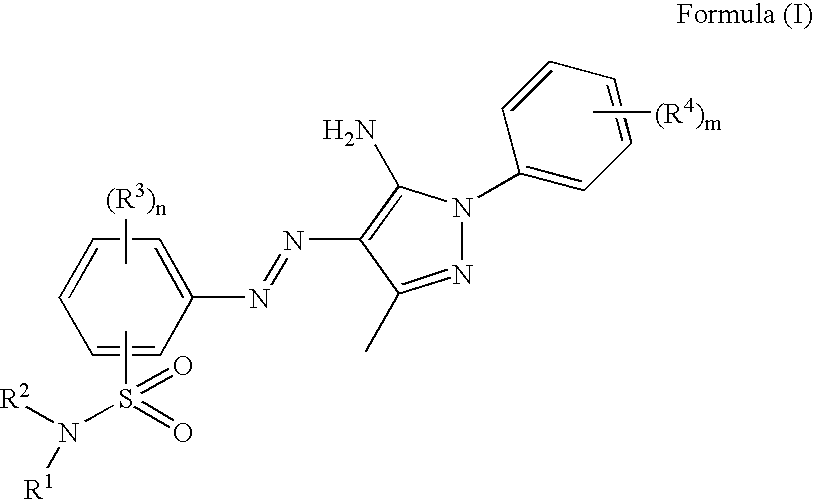Azo compound, colorant-containing curable composition, and color filter and method of producing the same
a technology of curable composition and compound, which is applied in the direction of photosensitive materials, other chemical processes, instruments, etc., can solve the problems of unsuitable absorption of phthalocyanine dyes, harmful to humans and environments, and inability to be useful yellow or magenta dyes, etc., to achieve superior heat resistance and light fastness, light fastness and molar extinction coefficient (chromatic value), the effect of high solubility
- Summary
- Abstract
- Description
- Claims
- Application Information
AI Technical Summary
Benefits of technology
Problems solved by technology
Method used
Image
Examples
synthesis example 1
Synthesis of the Exemplified Compound (1)
[0221]An azo compound according to the invention was synthesized according to the following process. The numerals (1) to (5) shown in the following each reaction step indicate the compounds (1) to (5).
[0222]
[0223]7.00 g of p-aminoacetoanilide (the above compound (1)), 8.54 g of cyclohexylmethyl bromide, 20 g of dimethylformamide (DMF) and 4.72 g of triethylamine were mixed and the mixture was stirred at 50° C. for 6 hours. After the stirring was finished, the reaction mixture was poured into water, which was then extracted with ethyl acetate. The ethyl acetate phase was washed with water several times. Magnesium sulfate and activated carbon were added to this ethyl acetate phase to carry out drying and discoloration and then subjected to filtration using celite. The ethyl acetate phase was concentrated and recrystallized from hexane / ethyl acetate to obtain 6.83 g of the aforementioned compound (2) (yield: 59.5%).
[0224]Next, 10.00 g of the com...
synthesis example 2
[0231]The azo compound (the foregoing exemplified compound (2)) of the invention was obtained in the same manner as in Synthesis Example 1 except that the compound (2) was altered to cyclohexylamine and 4-methoxy-2-nitrobenzenesulfonyl chloride was altered to 2-nitrobenzenesulfonyl chloride. Also, the structure of the azo compound was confirmed by NMR, and λmax, ε and half-value width of the azo compound were measured in the same manner as in Synthesis Example 1.
[0232]1H-NMR (300 MHz, solvent: dimethyl-d6sulfoxide, standard material: tetramethylsilane) δ8.00 ppm (2H, s), 7.91 (1H, d), 7.79 (1H, d), 7.67 (1H, t), 7.60-7.50 (4H, m), 7.50-7.35 (2H, m), 7.18 (1H, d), 3.20 (1H, m), 2.43 (3H, s), 1.55 (4H, m), 1.45 (1H, m), 1.25-0.90 (5H, m). λmax=392 nm, ε=17000 [l·mol−1 cm−1] and the half-value width=128 nm in methanol.
synthesis example 3
[0233]The azo compound (the foregoing exemplified compound (3)) of the invention was obtained in the same manner as in Synthesis Example 1 except that the compound (2) was altered to cyclohexylamine. Also, the structure of the azo compound was confirmed by NMR, and λmax, ε and half-value width of the azo compound were measured in the same manner as in Synthesis Example 1.
[0234]1H-NMR (300 MHz, solvent: dimethyl-d6sulfoxide, standard material: tetramethylsilane) δ8.02 ppm (2H, s), 7.85 (1H, d), 7.60-7.45 (4H, m), 7.40 (1H, m), 7.25 (1H, s), 7.02-6.85 (2H, m), 3.85 (3H, s), 3.10 (1H, m), 2.43 (3H, s), 1.55 (4H, m), 1.42 (1H, m), 1.20-0.85 (5H, m). λmax=394 nm, ε=17000 [l·mol−1 cm−1] and the half-value width=135 nm in methanol.
PUM
| Property | Measurement | Unit |
|---|---|---|
| visible wavelength | aaaaa | aaaaa |
| thickness | aaaaa | aaaaa |
| boiling point | aaaaa | aaaaa |
Abstract
Description
Claims
Application Information
 Login to View More
Login to View More - R&D
- Intellectual Property
- Life Sciences
- Materials
- Tech Scout
- Unparalleled Data Quality
- Higher Quality Content
- 60% Fewer Hallucinations
Browse by: Latest US Patents, China's latest patents, Technical Efficacy Thesaurus, Application Domain, Technology Topic, Popular Technical Reports.
© 2025 PatSnap. All rights reserved.Legal|Privacy policy|Modern Slavery Act Transparency Statement|Sitemap|About US| Contact US: help@patsnap.com



